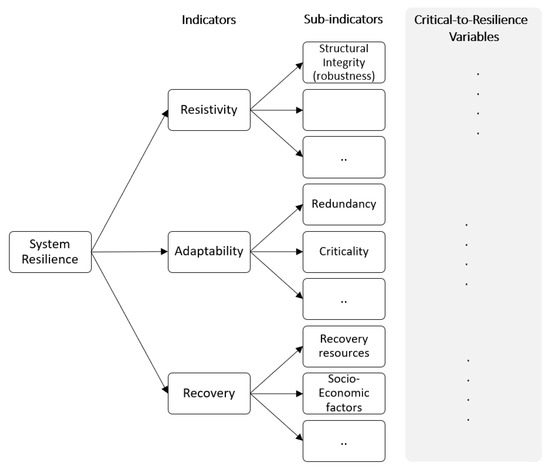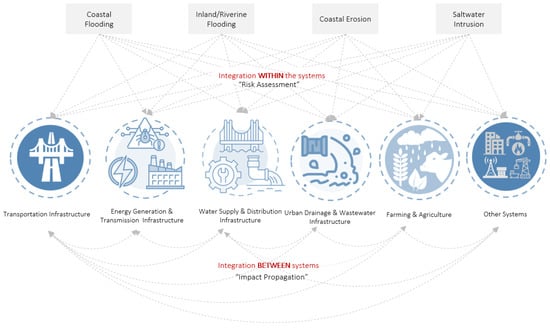Over the last century, eustatic sea-level rise (SLR) has increased more rapidly than it has at any time over the past three millennia. This rapid change, compounded by additional changes in relative vertical elevation at specific locations due to subsidence and isostatic effects, poses a significant threat to coastal communities. The potential impacts to communities include coastal and inland flooding, salt-water intrusion, and coastal erosion. These risks, which are expected to be exacerbated by continuing and accelerating rates of SLR in the future, have precipitated a need to design and implement adaptation measures to curtail future losses and make communities more resilient.
1. Multidimensionality and Composite Indicators
The reviewed work suggests and demonstrates that multiple metrics can be used to mathematically measure resilience and, consequently, facilitate its integration into adaptation planning. One effective way to achieve this integration is to develop mechanisms that aggregate multiple dimensions inherent in resilience into a single, multi-variate, composite indicator. Composite indicators ideally combine multidimensional concepts in some manner to produce a baseline. The quality of such an indicator, as well as the soundness of its underlying premises, depend not only on the methodology used in its construction (i.e., the aggregation methodology) but also on the validity of the underlying theory and the quality of the data used to reflect that theory (i.e., the selection of variables) [
7].
While the use of composite indicators in policy analysis is growing, its application to climate-based resilience, particularly in informing decision-making rather than global comparisons, is still nascent. Developing effective composite indicators alongside advancements in data analytics and prediction models can significantly contribute to ongoing research on operationalizing resilience. A key challenge in this endeavor is identifying resilience-leading indicators. Researchers emphasize the importance of selecting indicators based on their relevance and criticality in shaping system resilience, rather than solely relying on data availability. Given the complexity and dynamic nature of infrastructure systems, adopting a systems thinking approach can enhance understanding of how systems respond to climate threats and evolve under different adaptation strategies. Concepts such as causal hypotheses can be employed to establish the theoretical foundation for operationalizing resilience using the identified leading indicators. This process involves identifying and linking various indicators and sub-indicators, as depicted in Figure 1.
Figure 1. Hierarchical structure of resilience indicators, sub-indicators, and resilience-critical variables.
The second major challenge in constructing a composite resilience index is aggregating the leading indicators into a single multidimensional index. In the context of climate resilience, the most commonly used method for aggregation is linear addition of variables using equal weights [
17,
156]. Some examples include PEOPLES [
157] and BRIC [
8]. Other aggregation techniques include “fuzzified rules” such as min-max IF-THEN logic for conjunctive and disjunctive reasoning, weighted multi-criteria overlay analysis, and Analytic Hierarchy Process (AHP) [
7]. The fuzzy inference models generally specify explicit input conditions to generate an output. These conditions hinder the aggregation strategy from robustness while also assigning the same importance to all the fuzzified factors. AHP and weighted multi-criteria overlay analysis are mainly utilized to prioritize criteria based on the assigned weights. However, decision-making based on weighted comparisons, for the most part, relies on the judgment of the decision-maker and often results in the assignment of arbitrary weights. Moreover, in AHP, pairwise comparisons must be established to determine the weights since the main goal is to order factors in their importance. This process becomes computationally expensive with a potentially large number of variables, and the complexity of the process is further exacerbated by the selection of scale and range for the weights from an arbitrary spectrum.
Some statistical techniques for dimensionality reduction, such as Principal Component Analysis (PCA) and Factor Analysis (FA), are also proposed to aggregate the selected indicators into a composite index (proxy). For instance, in the PCA method, the first principal component is calculated as a linear combination of all the variables while preserving as much variation within the data as possible [
158,
159]. When applied to real cases with data imperfections and deficiencies, this approach may result in poorly constructed principal component(s) and provide misleading reflections of the underlying indicators. In general, such methods often result in a measure that does not reflect the established theory behind which multiple causal pathways are initially constructed. In that respect, there is a significant niche in the literature for novel aggregation methods specific to the context of measuring resilience to sea-level rise risks. For instance, an axiomatic fault-driven resilience metric has been proposed to bridge this gap in the context of SLR in a recent study [
111]. The axioms of the proposed framework are developed using a deductive (formative) construct based on the conditions essential for systems’ survival during and after disruptions. As such, the resulting composite metric does not require the assumption of statistical homogeneity of data and does not resort to weights to map the system capacities to resilience.
2. Integration: From Local View to Global Perspective
Urban critical infrastructure systems are densely collocated and reliant on each other to function effectively. Overall, the interdependence of urban critical infrastructure systems underscores the need for a holistic and integrated approach to their management and maintenance. Any disruption or failure in one system can have cascading effects on the others, highlighting the importance of an integrated approach in sustaining resilient and adaptive urban infrastructure systems. As such, both the direct and indirect impacts of SLR on a system must be assessed and incorporated in associated resilience measures (
Figure 2). In that respect, leading indicators can be employed to reflect not only the resilience of the components of a system but also their interaction with multiple systems. For instance, leading indicators are used in a recent study that focuses on onsite wastewater treatment and disposal systems to incorporate the impact propagation of these systems failing on freshwater resources in resilience metric generation process [
111]. In another study, a vulnerability assessment is proposed to address physical interdependencies between infrastructures, where the output at one node serves as an input for another [
160]. Besides the physical interdependence, other forms of infrastructure interdependencies were identified by Rinaldi et al. [
161]. These include: (1) cyber interdependency mapping the communication or information links and (2) geographic interdependency representing interactions between neighboring geographic locations. To our knowledge, these different forms of infrastructure inter-dependencies are yet to be addressed in the context of measuring resilience.
Figure 2. A diagrammatic representation of interdependencies across infrastructure systems (inclusive of other systems such as harbor, residential, communications, etc.) in the context of SLR impact.
Although it is essential to understand the marginal influence of specific risk types, more comprehensive and inclusive modeling approaches are needed for capturing resilience of systems to multiple risks in the context of developing holistic adaptation solutions. For example, in the context of SLR, all potential risks, such as coastal flooding, inland flooding, saltwater intrusion, and coastal erosion, must be inclusively addressed and reflected in the constructed resilience index. A noteworthy example is a study due to Snoussi et al. [
162], where the authors investigate the impacts of SLR on a coastal zone by quantifying and integrating measures related to both coastal erosion and flooding. Additionally, the study by Ciscar et al. [
163] proposes a comprehensive and holistic model for a collection of climate risks by fusing a variety of process models, such as flood models, various forecast models for coastal erosion, and rising groundwater levels under a collection of SLR scenarios. Extending such models to build metrics that capture the resilience of an overall urban system is a promising area for research. Leading indicators can offer the “joining points” to connect metrics across multiple systems (local models) within a larger system of systems framework (global model).
3. Inclusion and Coordination: From Infrastructure-Centered Resilience to People-Centered Resilience
Most of the resilience metrics pertaining to infrastructure systems tend to focus on the engineering aspects of the risks and often ignore the social and economic impacts. Therefore, solutions based on such metrics often overlook the uneven distribution of costs and impacts across social classes. Integrating the social determinants into the construction of resilience metrics will help prioritize addressing the needs of those on the front-line and those who already suffer from a range of social challenges and develop more equitable solutions. Such integration must be reflected in the adaptive and restorative capacities of the engineered systems and the communities they serve. People-centric indicators typically relate to social connectedness, equity and social justice, health and well-being, economic security and cultural preservation. Developing an inclusive methodology must account for community or region-wide resilience, which incorporates such factors as well as the inter-dependencies between multiple systems and regions. Only a small group of studies such as [
70,
90,
111,
140] can be cited from the extant literature that explicitly integrates socioeconomic factors into infrastructure resilience modeling.
Climate adaptation is of relevance and interest to a wide range of stakeholders and policymakers. Their engagement and participation can offer support during the planning and implementation stages. From the policy-making perspective, it is imperative to integrate multiple objectives and stakeholder incentives into the decision-making process to ensure actionable solutions. For example, some stakeholders are so risk-averse that the decision makers, acting on their behalf at the negotiations, are willing to invest heavily into infrastructure to minimize expected damages [
164], whereas decision-makers representing fiscally conservative stakeholders would argue for low investment-cost solutions. In either case, a traditional single-objective function masks these trade-offs leading to a locally optimal solution that could be inconsistent with these stakeholders’ preferences [
165]. In this regard, reaching a global optimal adaptation policy that addresses the stakeholders’ visions, which in some cases might be conflicting, is a challenging problem that needs further research. This challenge is exacerbated by the need for resilience metrics that can be aptly incorporated into objective functions.
Stakeholder coordination is crucial at the very early stages; when the theory behind the resilience metric is formulated, expert opinions, community needs, and concerns should be reflected in the metric by designing appropriate leading indicators that inclusively address the different perspectives on resilience. Such coordination ensures that leading indicators are grounded in the lived experiences and perspectives of community members, rather than being imposed from above by outside experts or authorities. Developing metrics with communities can help to identify and prioritize the factors that are most important for building resilience in a particular context. The indicators identified by such processes will have a higher chance of collective understanding, acceptance, ownership, and building trust. Several community engagement and community disaster resilience frameworks proposed in the literature [
166,
167] can be leveraged to develop methodologies for identifying indicators and co-constructing metrics that can be integrated into infrastructure resilience modeling.
This entry is adapted from the peer-reviewed paper 10.3390/jmse11071421


